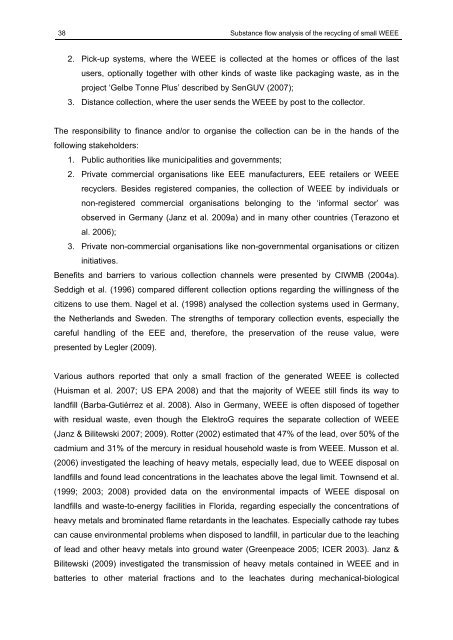SUbstance flow analysis of the recycling of small waste electrical ...
SUbstance flow analysis of the recycling of small waste electrical ...
SUbstance flow analysis of the recycling of small waste electrical ...
Create successful ePaper yourself
Turn your PDF publications into a flip-book with our unique Google optimized e-Paper software.
38 Substance <strong>flow</strong> <strong>analysis</strong> <strong>of</strong> <strong>the</strong> <strong>recycling</strong> <strong>of</strong> <strong>small</strong> WEEE<br />
2. Pick-up systems, where <strong>the</strong> WEEE is collected at <strong>the</strong> homes or <strong>of</strong>fices <strong>of</strong> <strong>the</strong> last<br />
users, optionally toge<strong>the</strong>r with o<strong>the</strong>r kinds <strong>of</strong> <strong>waste</strong> like packaging <strong>waste</strong>, as in <strong>the</strong><br />
project ‘Gelbe Tonne Plus’ described by SenGUV (2007);<br />
3. Distance collection, where <strong>the</strong> user sends <strong>the</strong> WEEE by post to <strong>the</strong> collector.<br />
The responsibility to finance and/or to organise <strong>the</strong> collection can be in <strong>the</strong> hands <strong>of</strong> <strong>the</strong><br />
following stakeholders:<br />
1. Public authorities like municipalities and governments;<br />
2. Private commercial organisations like EEE manufacturers, EEE retailers or WEEE<br />
recyclers. Besides registered companies, <strong>the</strong> collection <strong>of</strong> WEEE by individuals or<br />
non-registered commercial organisations belonging to <strong>the</strong> ‘informal sector’ was<br />
observed in Germany (Janz et al. 2009a) and in many o<strong>the</strong>r countries (Terazono et<br />
al. 2006);<br />
3. Private non-commercial organisations like non-governmental organisations or citizen<br />
initiatives.<br />
Benefits and barriers to various collection channels were presented by CIWMB (2004a).<br />
Seddigh et al. (1996) compared different collection options regarding <strong>the</strong> willingness <strong>of</strong> <strong>the</strong><br />
citizens to use <strong>the</strong>m. Nagel et al. (1998) analysed <strong>the</strong> collection systems used in Germany,<br />
<strong>the</strong> Ne<strong>the</strong>rlands and Sweden. The strengths <strong>of</strong> temporary collection events, especially <strong>the</strong><br />
careful handling <strong>of</strong> <strong>the</strong> EEE and, <strong>the</strong>refore, <strong>the</strong> preservation <strong>of</strong> <strong>the</strong> reuse value, were<br />
presented by Legler (2009).<br />
Various authors reported that only a <strong>small</strong> fraction <strong>of</strong> <strong>the</strong> generated WEEE is collected<br />
(Huisman et al. 2007; US EPA 2008) and that <strong>the</strong> majority <strong>of</strong> WEEE still finds its way to<br />
landfill (Barba-Gutiérrez et al. 2008). Also in Germany, WEEE is <strong>of</strong>ten disposed <strong>of</strong> toge<strong>the</strong>r<br />
with residual <strong>waste</strong>, even though <strong>the</strong> ElektroG requires <strong>the</strong> separate collection <strong>of</strong> WEEE<br />
(Janz & Bilitewski 2007; 2009). Rotter (2002) estimated that 47% <strong>of</strong> <strong>the</strong> lead, over 50% <strong>of</strong> <strong>the</strong><br />
cadmium and 31% <strong>of</strong> <strong>the</strong> mercury in residual household <strong>waste</strong> is from WEEE. Musson et al.<br />
(2006) investigated <strong>the</strong> leaching <strong>of</strong> heavy metals, especially lead, due to WEEE disposal on<br />
landfills and found lead concentrations in <strong>the</strong> leachates above <strong>the</strong> legal limit. Townsend et al.<br />
(1999; 2003; 2008) provided data on <strong>the</strong> environmental impacts <strong>of</strong> WEEE disposal on<br />
landfills and <strong>waste</strong>-to-energy facilities in Florida, regarding especially <strong>the</strong> concentrations <strong>of</strong><br />
heavy metals and brominated flame retardants in <strong>the</strong> leachates. Especially cathode ray tubes<br />
can cause environmental problems when disposed to landfill, in particular due to <strong>the</strong> leaching<br />
<strong>of</strong> lead and o<strong>the</strong>r heavy metals into ground water (Greenpeace 2005; ICER 2003). Janz &<br />
Bilitewski (2009) investigated <strong>the</strong> transmission <strong>of</strong> heavy metals contained in WEEE and in<br />
batteries to o<strong>the</strong>r material fractions and to <strong>the</strong> leachates during mechanical-biological

















